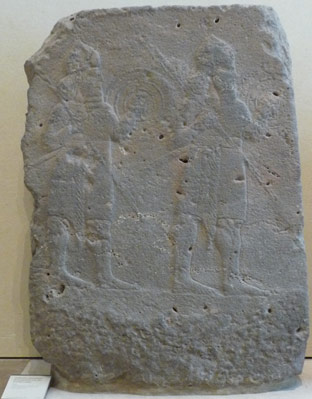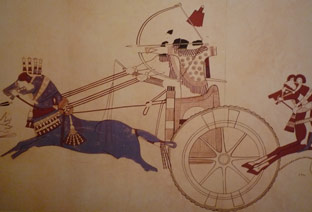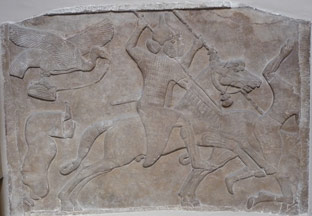The Assyrian army
As a consequence of the ongoing incorporation of the professional warriors of the armies of defeated neighbouring kingdoms from the 10th century BC onwards, the Assyrian army was slowly but steadily transformed into a professional standing army, with specialised soldiers largely replacing the conscripts who provided military service only during the summer months, when the agricultural calendar permitted the absence of farm workers.
An army of professional soldiers
The transformation from an army of conscripts to an army of professionals was concluded by the mid-8th century BC at the very latest. The main part of the armed forces of Tiglath-pileser III (744-727 BC), and of all his successors, consisted of professional soldiers from within the borders of Assyria and of mercenaries (or perhaps more accurately auxiliaries) from all adjoining regions; this was a standing army which could be supplemented with temporary troops drafted from the Assyrian population whose traditional duty of seasonal military service had not been formally abolished. In terms of specialisation, one can differentiate chariotry, cavalry and infantry. In terms of leadership, one can distinguish between the "royal cohort" (kiṣir šarrūti) under the command of the king and the troops under the authority of the provincial governors and the magnates.
The Assyrian army was in reality many armies, each with its own command structure; its composite character can be seen as the intentional product of a royal strategy which aimed to neutralise the military's otherwise unbridled power vis-à-vis the king in order to protect his sovereignty - a useful and successful approach that significantly contributed to Assyria's internal stability and the longevity of its royal dynasty. The different contingents which constituted the Assyrian army were allowed and encouraged to preserve and develop their own customs and idiosyncrasies: rather than being forged into a unified army, its individual components found themselves in intense competition with each other for royal recognition and favour.

The king, a mighty warrior
Ancient Near Eastern tradition judged a warrior's death reputable and praiseworthy, and those who bravely sacrificed their lives in battle could achieve eternal fame; the belief in this paradox is also well attested for Assyria, where respect and esteem in general were all-important. Courage in battle, and the desire to die a heroic death, is not claimed by the Assyrian sources for their own warriors alone; they also attribute these qualities to the enemy.
Such qualities were also expected from the Assyrian kings: in their official records, both Tiglath-pileser III and Sargon II (721-705 BC) portrayed themselves as operational fighters who personally led their men into the fray, as an episode from the account of Sargon's eighth campaign may illustrate: "With only my own chariot and the horses which are (always) with me, never leaving my side in enemy and friendly territory, (and) the contingent of (my brother) Sîn-ahu-uṣur, I hit (the enemy army) like a terrible arrow in its heart". Since Sargon died in battle, there is no reason to cast doubt on his active participation in combat. It was not the fact that he had fallen on the battlefield but that his corpse was never recovered (so that no proper funeral could be conducted) which caused an ideological crisis for Assyrian kingship that overshadowed the rule of his successors and changed their attitude to the front line.
Yet in the 8th century BC the king was still expected to pursue acts of personal heroism, as emerges clearly from archival sources which, unlike royal inscriptions, were not meant to impress an audience. Hence, a letter from one of Tiglath-pileser's officials expresses his expectation that the king should rise to the challenge of personally attacking the mountain fortress Turušpa, the capital of the kingdom of Urartu, Assyria's main rival at the time: "When the king, my lord, went up to Urartu for the first time, the gods Aššur and Šamaš delivered the city of Turušpa into the hands of the king, my lord. Hence, may the king, my lord, advance against Urartu so that they may conquer Turušpa and that the king, my lord, may immortalise his name!" (NL 45 = SAA 19 76).

Bravery on the battleground as a ticket to fame
The potentially lethal nature of war also made it attractive as it provided a chance to attain fame, regardless of eventual failure or success. This sentiment was attributed to the soldiers in the service of Assurbanipal (668-c. 630 BC) by their commanding officer Bel-ibni who quoted the words of his men in a letter to his king: in the course of a military operation in the marsh regions at the extreme south of Babylonia, a contingent of 150 soldiers suddenly found themselves ambushed just outside of enemy territory. Outnumbered by the 400 men of the hostile forces, they prepared for the perilous confrontation by executing the 130 enemy soldiers taken captive in a previous encounter, to prevent their liberation or uprising, and proclaimed in the face of this precarious situation: "Should we die, we will die with a supreme name!" (ABL 520). The Assyrian contingent was indeed victorious, killing 17 and wounding 60 or 70 men before putting the enemy troops to flight; yet 20 of the Assyrian soldiers suffered injuries and although some may have survived their battle wounds, other will certainly have died.

But to what extent did brave acts such as these, which were also undoubtedly meant to attract the attention and gratitude of the king, make a soldier's reputation? It is clear that, at least within the administrative and military cadres of the empire, certain army contingents (such as the Ituean PGP auxiliaries who were used as crack troops during the reign of Tiglath-pileser III) enjoyed a special appreciation, based undoubtedly on an outstanding past performance, both from the survivors and the dead.
That individuals, too, were held in high esteem for their accomplishments is evident from the honours and rewards which the king bestowed on war heroes and is perhaps most obvious when they were considered for future missions. The available evidence naturally favours high-ranking officers, such as the Chief Eunuch Ša-Nabû-šû (SAA 4 9, SAA 4 63, SAA 4 78-80, SAA 4 88, SAA 4 96), the most senior military officer under kings Esarhaddon (680-669 BC) and Assurbanipal, and his successor Nabû-šarru-uṣur (SAA 4 267, SAA 4 270-272, SAA 4 292), who were both routinely considered to lead the army in particularly difficult assignments, a clear indication of their excellent reputations.
Further reading
Archer, 'From chariotry to cavalry', 2010.
Dezsö, 'Reconstruction of the Assyrian army of Sargon II', 2006.
Fuchs, 'War das Neuassyrische Reich ein Militärstaat?', 2005.
Postgate, 'The invisible hierarchy', 2007.
Content last modified: 5 Nov 2012.
Karen Radner
Karen Radner, 'The Assyrian army', Assyrian empire builders, University College London, 2012 [http://www.ucl.ac.uk/sargon/essentials/soldiers/theassyrianarmy/]